December '09
Spalding TP Mills Putters
Although Spalding faded out of the golf equipment market by year 2000, they were a quality producer for about 100 years.
Baseball great, Albert Goodwill Spalding and co-hall of famer, George Wright of Wright and Ditson partnered with Philadelphia based AJ Reach,
to create a powerful multiple brand of sporting goods equipment thru the 1940's. Spalding was the golf lynchpin starting with US based golf club production in Chicago in 1894. Spalding went from lynchpin to kingpin of the golf industry as the game exploded in popularitly beginning around 1900.
The credits for Spalding in golf are innumerable (JM Cooper's book on the wood shaft years is a good start for those interested) and histories abound so no effort is made here to retell what others have researched and reported on better than I.
Fast forwarding to the late 1990's, management re-positioned the Spalding moniker into the low priced market attempting to make Top Flite the high end with the Ben Hogan acquisition situated at the professional tier. While the approach made sense on paper, it did not pan out and Spalding Inc went bankrupt to be subsequently acquired by Callaway to shore up their weak golf ball market share. Regardless of the final outcome, Spalding was a major market force in the golf industry through the major growth period of the game.
TP Mills
Truitt (TP) Mills started making hand forged putters in 1964. He differentiated his line by providing an accurately placed center-of-gravity mark on the top line which coincided with a face dot cross pattern.
TP built numerous custom putters for pros including Arnold Palmer. Custom designed TP Mills putters are still available from TP Mills' sons at their website.
Spalding Touring Pro Model
In the early 1970's, Spalding approached Mr. Mills to design putters. These early putters known as 'Touring Pro Models' were forged at Spalding and blackened by Mills. Although the records suggest the putters were gun-blued by Mills, it appears the finish was more a prime-paint finish. Gun bluing is a method to blacken carbon steel which is essentially a deep color rust coating. These early putters had the familiar dot cross face pattern along with TP's initials 'TPM' on the face at the heel and the words Touring Pro Model on the sole.
I believe the Touring Pro Models were offered up to 1982 in anticipation of a redesign to come about a year later. The Touring Pro Models had a large '0' on the topline, a ferrule and Roman numerals designating the model numbers which ranged from the I thru the IX. Their shafts were unfluted, in-hosel (note ferrule), unstepped, skinny steel. The models have a back-seam, flat top leather wrap grip with plastic collar and endcap.
A typical Touring Pro Model (1) and the most sought after, is shown below.

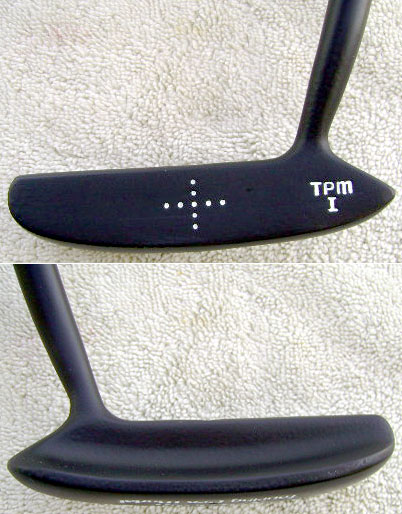

All the original Touring Pro Models are shown below.
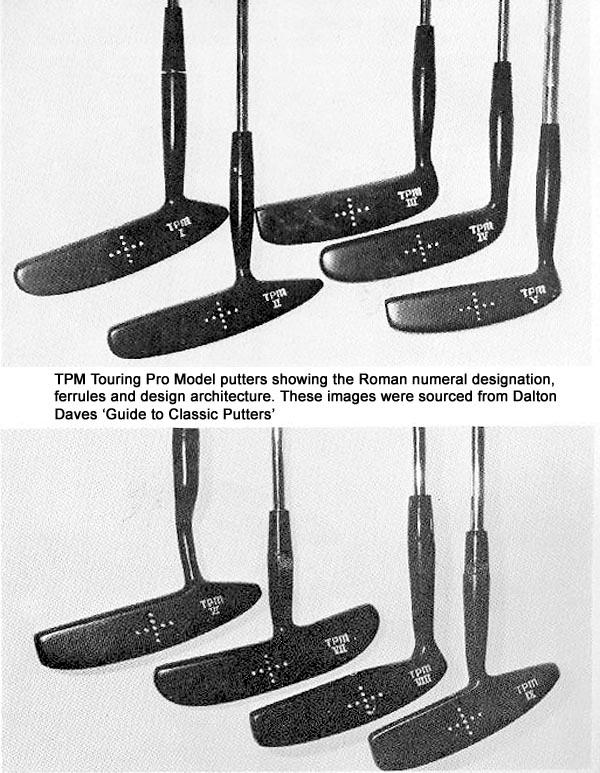
the TPM Model
In 1984, the TPM Model was introduced by Spalding. These putters were in a flat back tint with the dot cross face pattern and sweet spot dot on the topline. On the sole was the 'Spalding' logo centered along with 'precision milled' and 'designed by TP Mills' to either side. The whole head was black with white paintfill engraving.
The original 1984 offer included the # 1-6 and 7-12, with arabic numerals. In 1987 a # 14 was added - a # 13 was never offered. In 1989, a white alignment line was added to the topline. All the TPM models were flanged blades except the # 14 which was a mallet. The putters had in-hosel, skinny, fluted, unstepped steel shafts and flat top tapered rubber grips with the TPM logo.
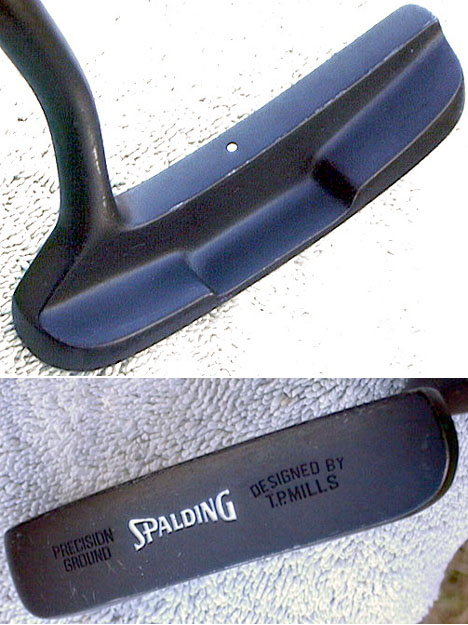

The TPM models ran from 1984 thru 1992(see typical image above).
All the original 1984 series TPM Models are shown below.
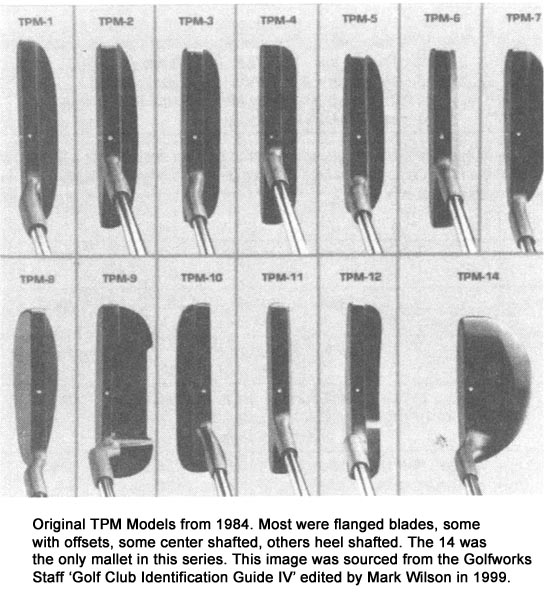
In the 1993/94 production run, the model was 'modified' with the introduction of the # 1, 6, 9, 10, 12, 14, 15, and 19 with an unpainted (not-black) face (see sample image below).
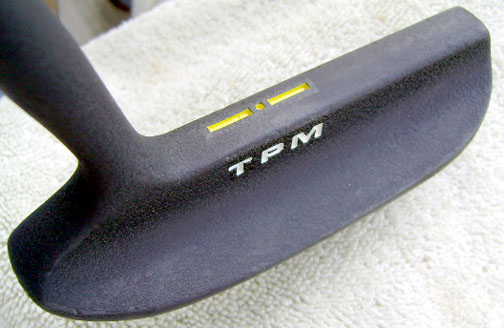
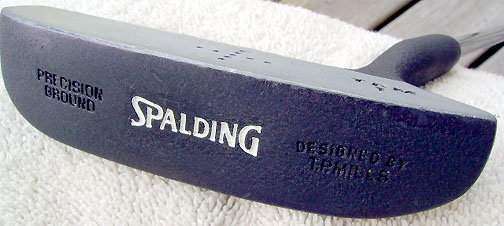

the TPM Tour Series Model
In 1985 a Tour Series Model was offered. This model ran thru 1992. These putters had a gold dot on the topline along with the words 'TPM Tour Series' on the face at the heel. Interestingly, the Tour Series models did not have the familiar dot face pattern of prior models and still in use for non-Spalding models. Sole engravings were the same as the TPM Models but were paint filled in gold, not white.
The original Tour Series models were the # 15, 16 and 17. In 1986, a model # 18 and 19 were added, the latter also with a graphite shaft option.
In 1988, the # 16 and 17 were discontinued. A gold alignment line was added to the topline in 1989. In 1991, the # 18 was discontinued. leaving only the 15 and 19 until 1992, when all the Tour Series putters were discontinued by Spalding.
Tour Series putters have in-hosel, non-fluted, unstepped steel shafts and a flat top rubber pistol grip with the 'TPM Tour Series' logo on top.
In 1993, a Tour Series II model was offered by Spalding. These putters had a low loft (original Mills putters had lofts in the 5 - 7 degree range) and an unpainted face and cavity generating a perimeter weighting similar to the brass models to come later. Note the perpendicular sight line on top and no dot face pattern.

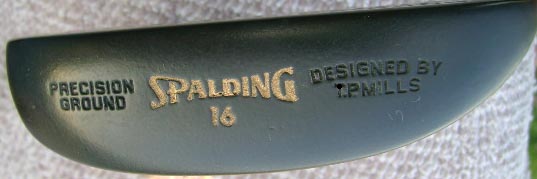

Above images of Tour Series and below, Tour Series II
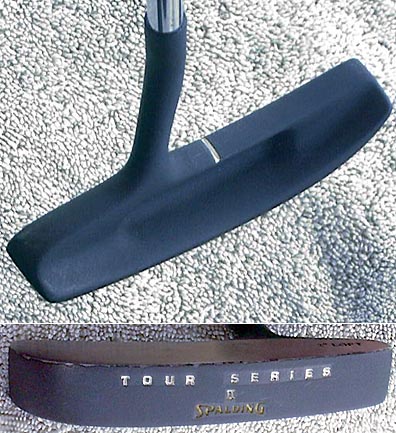

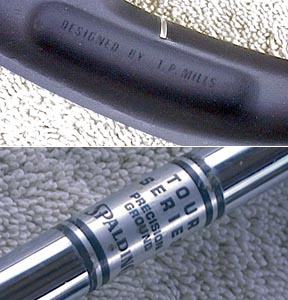
the TPM Gold Models
In 1987, the TPM Gold Models were introduced by Spalding. These were brass headed, perimeter weighted models in 4 models numbered in Roman I, II, III, and IV. The putters had the dot face pattern and were in a matte finish with black paint fill. They had overhosel, stepped steel shafts and flat top rubber grips with the TPM Gold logo on top. The putter line was discontinued in 1989.
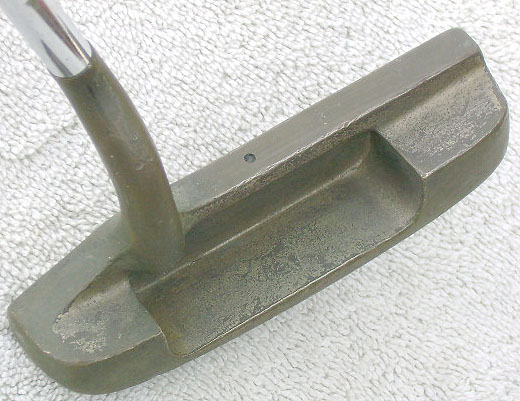

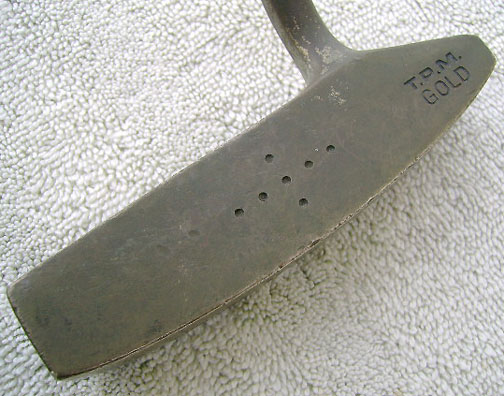
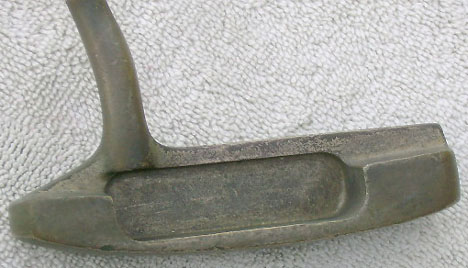
The putter descriptions and chronologies are intended to initially document the history of the TPM Spalding designs. The work is not complete and, over time, contributions by knowledgible readers to establish greater accuracy, are welcomed.